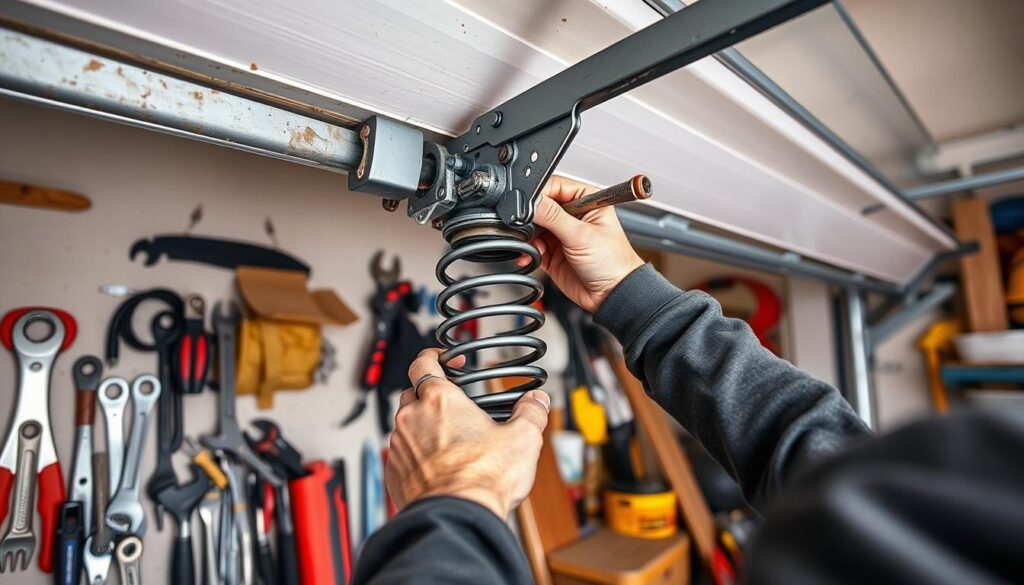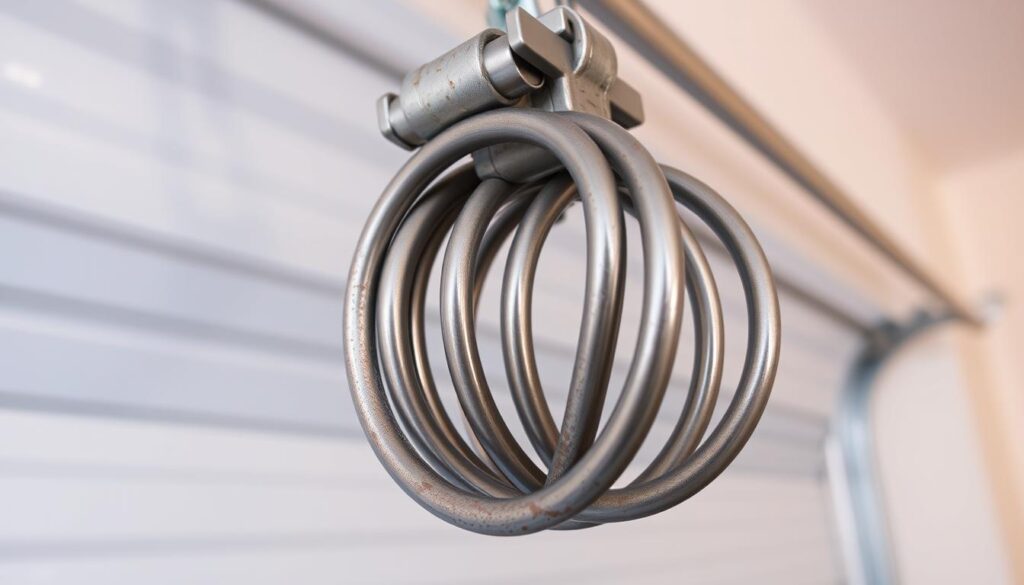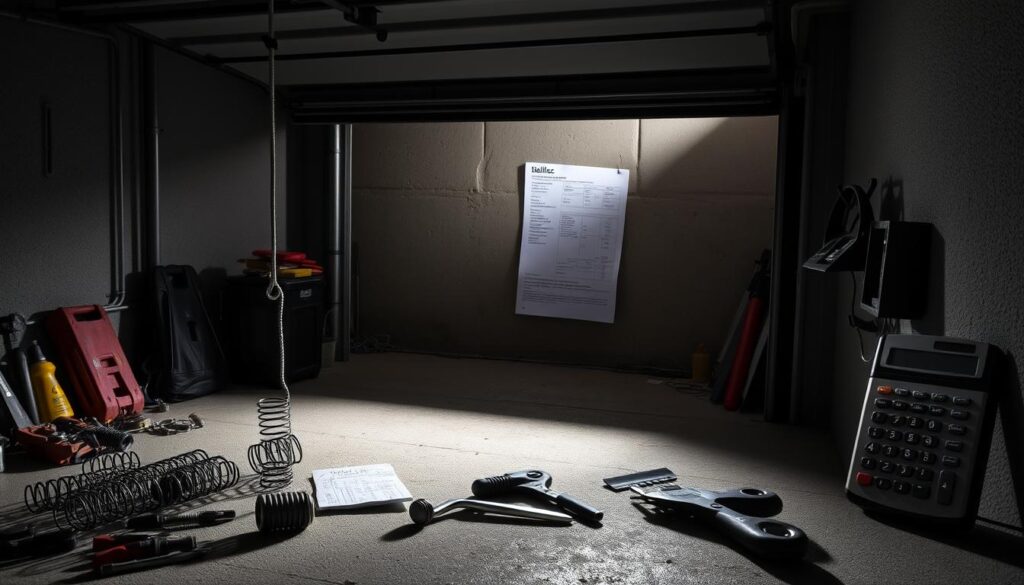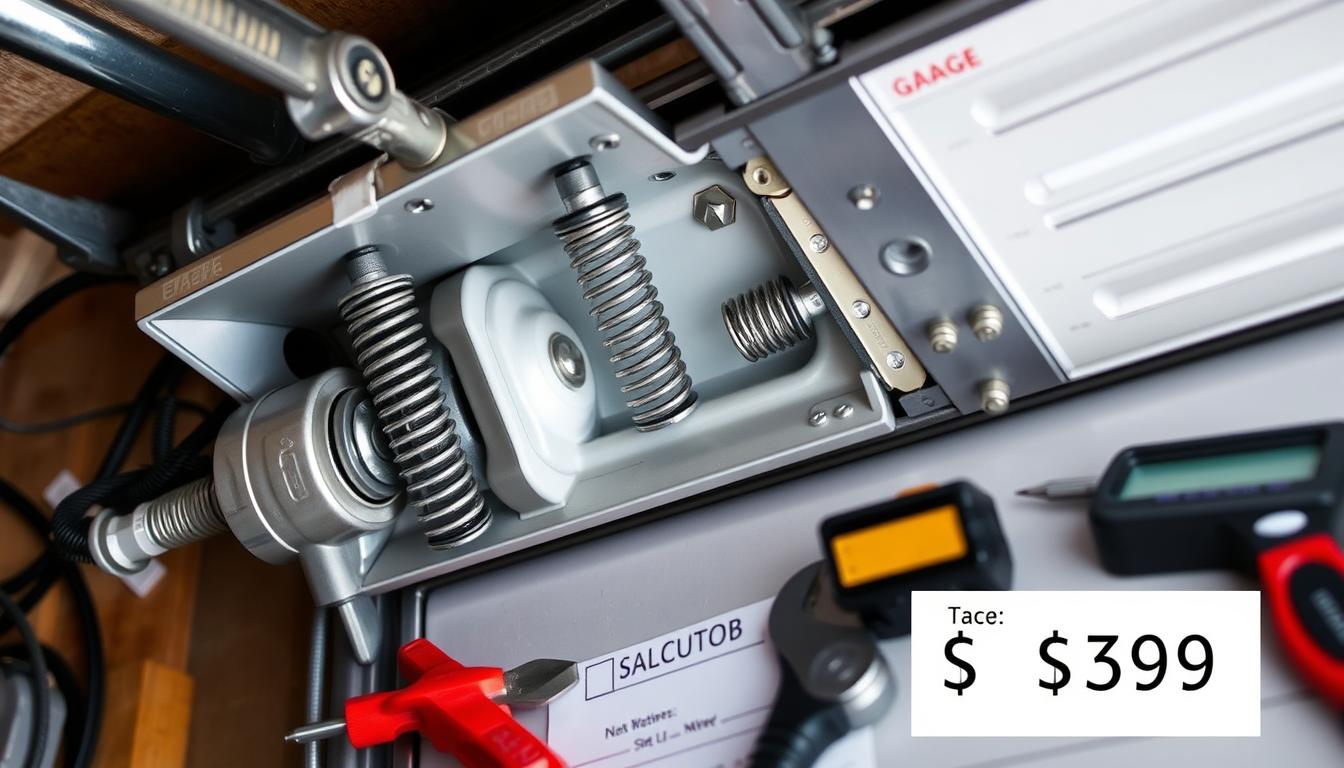Keeping your garage door working smoothly is key for both ease and safety. Often, homeowners need to replace old garage door springs. The price for this can change a lot, based on several things. In this detailed guide, we’ll look at the typical costs for replacing garage door springs. We’ll help you understand what affects prices and guide you in making smart choices for this important home upkeep task.
Key Takeaways
- Garage door spring replacement costs can range from $150 to $350 on average, with variations based on spring type, material quality, and labor rates.
- The type of spring system (torsion or extension) and the number of springs (single or double) can significantly impact the overall cost.
- Spring life expectancy and durability are crucial considerations when budgeting for replacement, as they can influence the frequency of needed repairs.
- Factors such as material quality, labor rates, and the need for emergency service can all affect the final cost of garage door spring replacement.
- Understanding the pros and cons of DIY versus professional spring replacement can help homeowners make the best decision for their specific needs and budget.
Understanding Garage Door Spring Types and Their Functions
Knowing about garage door spring types is key for replacement. There are mainly torsion springs and extension springs.
Torsion Springs vs. Extension Springs
Torsion springs sit above the door and twist to lift it. They are stronger and last longer than extension springs. Extension springs, on the other hand, stretch out to balance the door’s weight.
Single Spring vs. Double Spring Systems
Garage doors can have either a single spring or a double spring setup. Single springs are common, but bigger doors might need double springs for better operation.
Spring Life Expectancy and Durability
Spring lifespan varies from 5 to 20 years or more. It depends on usage, maintenance, and spring quality. Torsion springs are often more durable than extension springs.
“Proper spring selection and maintenance are essential for ensuring the long-term reliability and safety of your garage door.”
Knowing the differences between spring types helps homeowners choose the right one for their garage door. This is important for replacement and maintenance.
Average Cost Ranges for Garage Door Spring Replacement
The cost to replace garage door springs varies a lot. Industry research shows the average garage door spring replacement cost is between $150 and $350. This includes the cost of parts, labor, and extra services.
Here’s a closer look at the average costs for different scenarios:
- Torsion spring replacement: $200 to $300 per spring
- Extension spring replacement: $100 to $200 per spring
- Single spring system replacement: $150 to $250
- Double spring system replacement: $300 to $500
Keep in mind, these are just estimates. The real average garage door spring replacement cost can change. It depends on your garage door’s needs, the quality of parts, and local labor costs.
Knowing the cost range for spring replacement helps homeowners plan for garage door maintenance costs.
Factors That Influence Garage Door Spring Replacement Costs
Several key factors affect the cost of replacing garage door springs. Knowing these can help homeowners plan their expenses better.
Material Quality and Spring Size
The quality of the springs greatly impacts the cost. Springs made from galvanized or stainless steel are more durable but pricier. The size of the springs also matters, with bigger ones costing more.
Labor Rates by Region
Labor costs vary by region. Technicians in urban areas often charge more than those in rural areas. Knowing the labor rates in your area helps with budgeting.
Emergency vs Scheduled Service
The timing of the service affects the cost too. Emergency services, where a technician comes right away, cost more. Scheduling during regular hours can save on labor costs.
| Factor | Impact on Cost |
|---|---|
| Material Quality | Higher-grade materials cost more |
| Spring Size | Larger springs are more expensive |
| Labor Rates | Vary by geographic region |
| Service Timing | Emergency service costs more than scheduled |
Understanding these factors helps homeowners budget better for garage door spring replacements.
DIY vs Professional Spring Replacement: Cost Comparison
Homeowners face a choice when it comes to garage door spring replacement: DIY or professional help. Each option has its own cost considerations. Let’s explore the financial aspects of both choices.
DIY Garage Door Spring Replacement
For those who enjoy DIY projects, replacing garage door springs can save money. The cost usually falls between $50 to $150, covering tools and materials. This option is great for those with the right skills and tools.
Professional Garage Door Spring Replacement
Choosing a professional offers a more reliable and comprehensive solution. The cost can range from $150 to $350. This depends on the type of springs, labor rates, and any extra services needed.
| Cost Factor | DIY Garage Door Spring Replacement | Professional Garage Door Spring Replacement |
|---|---|---|
| Average Cost Range | $50 – $150 | $150 – $350 |
| Risks and Considerations |
|
|
The choice between DIY and professional spring replacement depends on your skills and resources. Consider the risks and costs to decide what’s best for you and your budget.

How Much Does a Garage Door Spring Replacement Cost in Different States
The cost of replacing a garage door spring varies by location. Regional labor rates, material costs, and local demand play a big role. These factors cause prices to differ across the United States.
Cost Variations by Geographic Location
In urban areas, garage door spring replacements cost more than in rural areas. This is because labor and overhead costs are higher in cities. Also, competition among service providers in cities can push prices up.
For example, in New York City, the average cost is $200 to $400. In a small Iowa town, it’s $150 to $250.
Urban vs. Rural Pricing Differences
The table above shows the cost differences between urban and rural areas for garage door spring replacement. Prices can vary by 30-40%, with cities usually charging more.
When planning to replace your garage door spring, look up local providers. Compare their prices to find the best deal for your area.
Signs You Need a Garage Door Spring Replacement
Knowing when to replace your garage door springs is key for safety and smooth operation. Ignoring signs of spring failure can cause unexpected breakdowns, damage, or injury. Let’s look at the signs that mean it’s time for a spring replacement.
- Increased Effort to Lift the Door: If your garage door is harder to open or close, it might mean the springs are weakening.
- Unbalanced or Uneven Door Operation: If one side of the door lifts faster or feels off, it shows the springs aren’t balanced.
- Visible Wear and Tear: Look for corrosion, fraying, or damage on the springs. These signs mean they’re not good anymore.
- Frequent Repair Needs: If you’re always calling for repairs, it’s likely the springs need to be replaced soon.
Spotting these signs of garage door spring failure helps you act fast. This can save you time, money, and trouble later on.

“Don’t wait until your garage door springs break to replace them. Regular maintenance and paying attention to the warning signs can help you avoid a sudden and potentially dangerous failure.”
Additional Services Often Bundled with Spring Replacement
When you need your garage door springs replaced, you might also get other services. These extras can make your garage door last longer and give you peace of mind. But, they might also increase the cost.
Maintenance Packages
Many companies offer maintenance packages for garage doors. These include regular checks, oiling, and adjustments. Garage door maintenance packages help your door work well and last longer. They might cost more, but they’re worth it for keeping your door in great shape.
Warranty Options
Service providers also offer spring replacement warranty options. These warranties cover the cost of new springs if they fail early. The length and details of these warranties vary. It’s key to check them carefully to see if they’re right for you.
Thinking about these extra services helps homeowners make smart choices. They can save money in the long run and keep their garage door working well for years.
Hidden Costs and Potential Additional Expenses
When planning to replace your garage door springs, remember the hidden costs. These can surprise you and increase the project’s total cost. It’s important to be ready for these unexpected expenses.
One hidden cost is extra repairs or replacements. For example, if the spring replacement shows problems with the opener, rollers, or other parts, costs can rise quickly. The initial estimate might not cover these extra costs.
- Replacement of damaged or worn-out garage door parts
- Upgrades to the garage door opener or other components
- Unexpected structural repairs, such as to the door frame or track
Another hidden cost is specialist services. If your garage door is big, heavy, or complex, extra equipment or people might be needed. This can increase the final cost.
| Hidden Cost | Average Additional Expense |
|---|---|
| Replacement of damaged or worn-out parts | $200 – $500 |
| Upgrades to garage door opener or components | $300 – $800 |
| Structural repairs | $150 – $1,000 |
| Specialist services for large or complex doors | $100 – $500 |
To avoid hidden costs of garage door spring replacement and unexpected expenses, talk to your contractor. Discuss the project’s scope and possible extra work. This way, you can budget better and have a smoother experience.

Time Frame and Installation Process Overview
Replacing a garage door spring is a precise task that needs skill. The garage door spring installation process follows standard steps for safety and efficiency. Knowing the spring replacement time frame helps homeowners plan better.
Standard Installation Steps
- Assessing the existing spring: The technician checks the current spring’s condition to see if it needs to be replaced.
- Releasing tension: The spring’s tension is carefully released to avoid sudden or dangerous movements.
- Removing the old spring: The technician safely removes the old spring without damaging the garage door or other parts.
- Installing the new spring: The new spring is installed and tensioned as per the manufacturer’s instructions.
- Testing the door’s operation: The technician tests the door to make sure it opens and closes smoothly.
- Final adjustments: Any final adjustments are made to ensure the door operates perfectly.
Expected Completion Time
The spring replacement time frame depends on the job’s complexity, the technician’s experience, and the condition of the parts. Usually, a standard garage door spring replacement takes 1-2 hours, unless there are unexpected issues or extra repairs needed.
| Task | Estimated Time |
|---|---|
| Assessing the existing spring | 15-30 minutes |
| Releasing tension and removing old spring | 20-40 minutes |
| Installing new spring and adjusting | 30-60 minutes |
| Testing and final adjustments | 10-20 minutes |
| Total Estimated Time | 1-2 hours |
These times can change based on the job’s complexity and the technician’s skill. Always talk to a professional for a precise timeline for your garage door spring replacement.
Choosing the Right Contractor for Spring Replacement
Choosing the right garage door spring replacement contractor is key for a successful project. Here are important factors to consider when picking a garage door spring installation service provider:
- License and Insurance: Make sure the contractor is licensed and insured. This protects you from liability in case of accidents or damages during the repair.
- Experience and Expertise: Choose a contractor with lots of experience in garage door spring replacement. They should have the skills and knowledge to meet your needs.
- Reputation and Reviews: Check the contractor’s reputation by looking at online reviews and testimonials. This helps you understand the quality of their work and customer service.
- Warranty and Guarantees: Ask about the contractor’s warranty coverage and any guarantees they offer. This can give you peace of mind and protect against future problems.
- Transparent Pricing: Get detailed quotes from several contractors. Compare their prices and any extra fees or hidden costs. This ensures you get a fair deal.
By considering these factors, you can find a reliable and professional garage door spring replacement contractor. They will deliver quality results and make the experience hassle-free.
| Key Factors to Consider | Why It Matters |
|---|---|
| License and Insurance | Protects you from liability in case of accidents or damages |
| Experience and Expertise | Ensures the contractor has the necessary skills and knowledge |
| Reputation and Reviews | Provides insight into the quality of work and customer service |
| Warranty and Guarantees | Offers protection against future issues with the repair |
| Transparent Pricing | Ensures you’re getting a fair and transparent deal |
“Choosing the right contractor for your garage door spring replacement is crucial to ensure a smooth and successful project. Take the time to do your research and make an informed decision.”
Maintenance Tips to Extend Spring Life and Reduce Future Costs
Keeping your garage door springs in good shape is key to making them last longer. By following some simple garage door spring maintenance tips, you can extend their life. This will save you money in the long run.
Lubricate Regularly
One of the best ways to extend spring lifespan is to lubricate them regularly. Do this every 6-12 months. Use a high-quality garage door lubricant on the coils. This keeps them moving smoothly and prevents rust or debris buildup.
Inspect and Adjust Tension
Checking your garage door springs and adjusting their tension is also important. Do this regularly to prevent wear and tear. Look for any damage or uneven stretching. Adjust them to keep them balanced.
Balance the Door
Keeping your garage door balanced helps your springs last longer. Make sure the door moves smoothly when opened and closed. Fix any issues with rollers, pulleys, or other parts that might cause imbalance.
| Maintenance Tip | Frequency | Benefits |
|---|---|---|
| Lubricate Springs | Every 6-12 months | Prevents rust, reduces wear and tear |
| Inspect and Adjust Tension | Regularly | Ensures even stretching and balanced operation |
| Balance the Garage Door | As needed | Reduces strain on the springs |
By following these garage door spring maintenance tips, you can extend the lifespan of your springs. This might also mean you won’t need to replace them as often. Remember, regular maintenance keeps your garage door working well for a long time.
Warranty Coverage and Long-term Cost Considerations
Understanding the warranty and long-term costs of garage door spring replacement is key. Manufacturers often provide warranties on their springs. This gives homeowners peace of mind and protects against unexpected costs.
Manufacturer Warranties
Most garage door spring makers offer warranties that last from 3 to 10 years. These warranties cover the cost of the spring if it fails early. But, they might not cover labor costs or all types of failures.
Service Provider Guarantees
Many garage door repair services also offer their own guarantees. These can last from a few months to a year or more. They often cover both parts and labor. It’s smart to ask about their warranties and guarantees when choosing a service provider.
Knowing about warranties and long-term costs helps homeowners make smart choices. This protects their investment and reduces future repair costs. Researching these factors ensures your garage door works well for years.
| Manufacturer Warranty | Service Provider Guarantee |
|---|---|
| 3-10 years coverage on spring itself | Typically 6 months to 1 year on parts and labor |
| May have exclusions or limitations | Ensures long-term value and protection |
| Provides protection against unexpected expenses | Varies by service provider |
By considering garage door spring warranties and long-term cost considerations, homeowners can make wise choices. This safeguards their investment and reduces future repair costs.
Conclusion
The cost to replace garage door springs can change a lot. It depends on the springs’ type and size, the materials used, and local labor costs. Knowing these factors is key when planning for this important home upkeep.
While DIY might seem appealing, professional help is usually safer and more reliable. A trusted contractor ensures the springs are installed right. This means you get a warranty, and your springs last longer, saving you money in the long run.
This article has given you the info you need to decide on garage door spring replacement. Consider the garage door spring replacement summary and cost considerations recap. This will help you make the best choice for your home and wallet.





